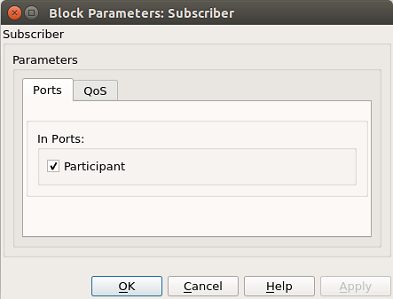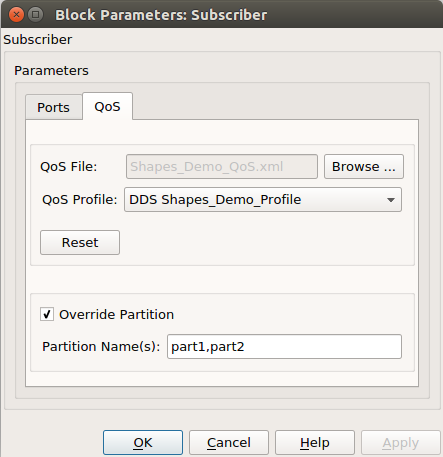9. Subscriber Block¶
The Subscriber block represents a DDS subscriber entity.
In DDS, a subscriber is “an object responsible for receiving published data and making it available to the receiving application. It may receive and dispatch data of different specified types.”
This block is optional on a DDS Simulink model diagram. If it is not present on a model diagram, each reader will create its own default subscriber.

Port Type |
Optional |
Name |
Description |
Output consumed by |
|---|---|---|---|---|
Input |
yes |
pp |
DDS Domain Participant entity instance |
|
Output |
no |
psub |
DDS Subscriber entity instance |
Reader |
9.1. Subscriber Block Parameters¶

9.1.1. Ports Tab¶
The Ports tab allows the user to toggle on or off optional ports.
9.1.2. QoS Tab¶
The QoS tab is used to set the QoS profile. By default, the OSPL default profile is used.
In DDS - The Data-Distribution Service (DDS) relies on the usage of QoS. A QoS (Quality of Service) is a set of characteristics that controls some aspect of the behavior of the DDS Service.
Each DDS block has an associated QoS profile. By default, the OSPL default profile is used. An XML file that specifies QoS profiles can be used to set the QoS of a DDS block.
Override Partition
The QoS tab is also used to override the partition name of the Subscriber QoS. By default, the Override Partition field is not selected and the partition name given in the QoS provider file is used.

Checking the Override Partition field specifies that it will override the partition name of the Subscriber QoS.
The Partition Name(s) field is for providing comma separated strings for partition names. Leaving it empty means the partition name will be set to the default value.
